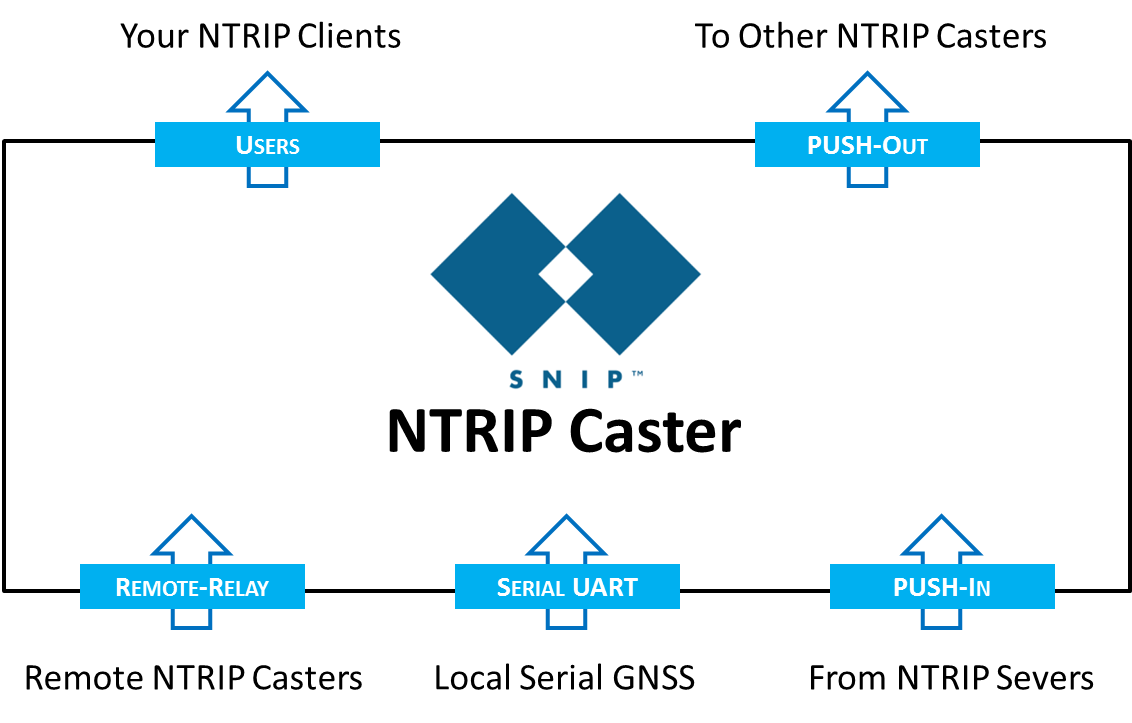Unlike most Casters, SNIP Supports four basic types of data streams: PUSH-In, PUSH-Out, RELAY, and UART. These are used to gather and send your different corrections streams to your clients. Two additional data stream types are also supported; a NEARest mountPt functionality and support for older RAW TIP/IP sockets are also provided Each of these six connection methods is grouped into a tab of its own in the SNIP GUI design. SNIP also supports more than just RTCM rev3 message content. You can send many other types of data (see the article on using SNIP as a bent pipe). You can also gather these streams into NEAR types.
These features makes SNIP unique and useful for any person who needs to assemble a network of RTCM corrections or other data sources for their own purposes. To best use SNIP, it is important to understand how stream data is gathered into the caster itself.
Stream Types
- PUSH-In Data, The traditional NTRIP flow of data sent to SNIP by a remote NTRIP Server device, used by large and small network operators.
See the PUSH-In Streams tab for further details. - PUSH-Out Data, In this model, data is sent by SNIP to another remote NTRIP Caster device,
so that the Caster can serve your data to others. Combined with services like RTK2go.com this is an easy way to publish your corrections data.
See the PUSH-Out Streams tab for further details. - RELAY Data, which is NTRIP data gathered from another remote Caster, with SNIP connected as a Client to that Caster. Used to build up the network you require.
See the Relay Streams tab for further details. - UART Data, where a local serial or USB port is used to connect to a data sender
(typically a GNSS reference station), and the need for an intermediate NTRIP Server
(the name of the element that sends the data from the GNSS devices) is no longer needed.
See the Serial Stream tab for further details. - NEARest Data, where a set (or sub set) of the data streams on your SNIP node is used to create a special mountPt where NTRIP Client which provide their location will be automatically connected to the best Base Station.
See the Nearest tab for further details. - RAW TCP/IP Data, Slots can be created for an an individual connection to an older GNSS device (one that does not support the NTRIP protocol) allowing them to connect similarly to an PUSH-In data connection.
See the RAW TCP/IP tab for further details.
Items #3 and #4 of these bear additional mention.
The RELAY solution Unlike a more traditional Caster, SNIP will reach out and connect to other remote Casters to create (we use the term federate) a custom network from these heterogeneous sources. This allows building a network made up of the data streams you wish to use for consistent data logging and management. See the Relay Streams tab for details.
The UART solution For many applications, the additional cost of having a GNSS reference station that also implements the NTRIP Server protocol (and therefore sends data to a predefined Caster) is cost prohibitive. Often such devices can also connect and send data with a serial port (also referred to as a UART port or a USB). SNIP provides a ready means to connect one or more such devices directly, overcoming the need for a separate NTRIP Server element. See the Serial Streams tabs for more details.
These different types of data streams, along with the need to manage the clients and the status of the caster itself, have led to the tabbed display used in the SNIP GUI. The connection details for each type of stream (called a slot) is handled in its own tab of the GUI, where all streams of that type are managed.
The licensing model used by SNIP keeps a running count of all the streams. A flexible licensing is used where each copy of SNIP is allowed up to a selected number of simultaneous streams based on the model purchased. Keys for additional streams can be purchased when required. However, the free community Lite model of SNIP does not allow purchasing such keys. The free community Lite model is also not able to run a NEARest style mountPt, use PFAT, or to accept RAW TCP/IP connections.
For an overview of how to filter the console display by stream types, try here.
For a general overview of SNIP, try here.
Need to use SNIP with Older Pre-NTRIP Base Stations…
This is easily done. When using such streams, there is not a NTRIP layer, only a simple TCP/IP connection. As a consequence you will need to provide a mountPt name for others to use for the stream in the setup process.
If the stream will be connecting to your Caster…
Use the Raw Tab for this. See this article for more details of how to setup.
If your Caster will connect to the Stream….
Use the Remote-Relay Tab for this. SNIP will connect to the remote host machine expecting a proper NTRIP exchange. The remote host has no idea what that is and will just start sending data back into the open TCP/IP connection. SNIP will detect what is occurring and simply deal with it; doing all the various stream establishment and auto-parse functions to set the rest of the needed details.

